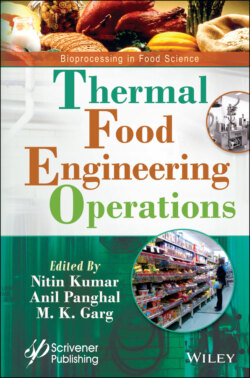Читать книгу Thermal Food Engineering Operations - NITIN KUMAR - Страница 30
1.3.4.3 Applications
ОглавлениеOhmic heating has several uses in the food processing industry. It has successful applications in various food products (solids or liquid/fluids or a mixture of both); like juices, fruits and vegetables, stews, meats, sauces, pasta, soups, and seafood.
In the initial years, the application of ohmic heating in beetroots resulted in improvement in the diffusion of betanin from the beetroot tissue, and its concentration and electric field strength were studied. Then studies carried out on radish in which heating rate was analyzed concerning frequency, which stated an increase in AC frequency leads to an increase in heating rate. Also, electrically heated foods are influenced by their mass transfer properties.
With time, its potential applications discovered in a huge amount such as in blanching, dehydration, fermentation, evaporation, extraction, etc.
The electric resistance heating process provides a chance for the production of new, high value-based, shelf-stable food products of quality that could not be realized before with current sterilization technology [54].
1 Blanching: Ohmic heating can enhance process efficiency in blanching, e.g, Ohm heating has rapid and uniform heating; hence there is no need to dice vegetables due to an effective method of ohmic heating, which has a fast turnaround time and less surface area. Blanching of mushrooms with the application of ohmic heating resulted in shrinking at lower temperatures with less water use compared with conventional ones.
2 Evaporation: Using electric resistance heating results in a threefold increase in the evaporation rate and hence improved product quality.
3 Dehydration: Improved dehydration rates of vegetable tissues, for example, Treating (with ohmic heating) sweet potatoes before dehydration significantly speeds up hot air drying compared to the traditionally processed samples. It also has seen the acceleration in vacuum drying rate of sweet with minimal ohmic pretreatment.
4 Fermentation: Enhanced extraction of components from different food products. For example, Ohmically pretreated apple tissue showed an increase in the yield of mechanical juice extraction. Also, ohmically treated rice bran showed an increased extraction of RBO (rice bran oil) (particularly at lower frequencies (say, 1Hz)) using ohmic heating.
5 Microbial Inactivation: Resistance heating is fatal to almost all microorganisms. Lower D-value and z-values were recorded in studies for microbial inactivation. A study by [71] resulted in a higher microbial death rate deactivating viable milk aerobes and S. Thermophilus using ohmic heating. Death of microbes in ohmic heating is due to the higher temperatures or increased electric field strength [34].
6 Enzymes Inactivation: Electric resistance heating generates an electric field which is found to be efficient for rapidly inactivating the enzymes such as lipoxygenase, polyphenol oxidase, pectin esterase than traditional heating systems [34]. For example,(i) Dynamics of polyphenol oxidase deactivation during ohm heating of grape juice studied, and ohmic heat treatment at various potential gradients applied to grape juice at specific temperatures. Changes in PPO enzymatic activity were noted.(ii) Declination in the activity of exogenic pectin methylesterase enzyme present in cloudberry jam and apple juice using ohmic heating and it follows rate law.(iii) Resistance heating with continuous alternating current resulted in successful deactivation of Bacillus subtilis spores in orange juice in a short duration of time, using a pressurized electric sterilization system; also reduction in peculiar smell and loss of ascorbic acid observed in the studies.
7 Extraction rate increase: Plant tissues pretreated ohmically at moderate temperatures and maximum efficiency in the extraction of juices by pressing was seen, e.g., increased efficiency of sucrose extraction from sugar beet; improvement in the dispersion of soymilk from soybeans. Ohmically treated products have higher retention value of color and nutrition, lower processing times, and higher extraction yields [34].Other Applications of Ohmic Heating: (Ohmically treated food materials) [21]Peeling and tissue softening of Ohmically treated and cooked Red beet, carrot, golden carrot, radish, turnip, potato, cabbage, apple, etc.Resistance heating improved the folic acid content of apple due to electropermeabilization.Inactivation of enzymes and reduction in textural changes during storage in pineapple observed using resistance heating.Thermal and non-thermal effects of OH in the meat thawing process and beef cuts.Application in producing products (e.g., ham and bologna emulsions, frankfurters, burger patties, etc.) with properties like soft, less cohesive, less elastic, mushier, less resilient, chewier, and good textural products in a short span of time.Improved firmness in pound cakes.Thermal denaturation of Tofu: Better process control observed and increased in apparent breaking strength and young’s modulus.
8 Rapid heating rates in different types of pickles (1-5°C per second), full-cream milk (7-50°C per second), cut pieces of pork and beef; Low heating and conductivity in fruits, margarine, etc. [61].
9 Time reduction in Bread dough proofing to achieve higher expansion because of high heating rates.
10 The heat source for desalination processes and reduction in processing time in ethanol distillation; better process control in ohmic assisted hydrodistillation.
11 Food Package for long-duration space missions and military; producing shelf-stable food products with better process control, e.g., Pulsed OH treated retort pouches for space missions [46].
12 Reduction of PPO in ohmically treated sugarcane juice, the complete deactivation of PPO in apples, in watermelon juice, in grape juice at a particular temperature-time combination.
13 POD inactivation in broccoli, potato, carrot, sugarcane juice, pumpkin, and artichoke heads in shorter duration and retention of nutrients [46].
